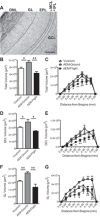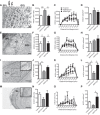The effect of spaceflight on mouse olfactory bulb volume, neurogenesis, and cell death indicates the protective effect of novel environment
- PMID: 24744382
- PMCID: PMC4152162
- DOI: 10.1152/japplphysiol.01174.2013
The effect of spaceflight on mouse olfactory bulb volume, neurogenesis, and cell death indicates the protective effect of novel environment
Abstract
Space missions necessitate physiological and psychological adaptations to environmental factors not present on Earth, some of which present significant risks for the central nervous system (CNS) of crewmembers. One CNS region of interest is the adult olfactory bulb (OB), as OB structure and function are sensitive to environmental- and experience-induced regulation. It is currently unknown how the OB is altered by spaceflight. In this study, we evaluated OB volume and neurogenesis in mice shortly after a 13-day flight on Space Shuttle Atlantis [Space Transport System (STS)-135] relative to two groups of control mice maintained on Earth. Mice housed on Earth in animal enclosure modules that mimicked the conditions onboard STS-135 (AEM-Ground mice) had greater OB volume relative to mice maintained in standard housing on Earth (Vivarium mice), particularly in the granule (GCL) and glomerular (GL) cell layers. AEM-Ground mice also had more OB neuroblasts and fewer apoptotic cells relative to Vivarium mice. However, the AEM-induced increase in OB volume and neurogenesis was not seen in STS-135 mice (AEM-Flight mice), suggesting that spaceflight may have negated the positive effects of the AEM. In fact, when OB volume of AEM-Flight mice was considered, there was a greater density of apoptotic cells relative to AEM-Ground mice. Our findings suggest that factors present during spaceflight have opposing effects on OB size and neurogenesis, and provide insight into potential strategies to preserve OB structure and function during future space missions.
Keywords: activated caspase-3; doublecortin; environmental enrichment; low Earth orbit; neuroblasts.
Copyright © 2014 the American Physiological Society.
Figures


Similar articles
-
Spaceflight environment induces mitochondrial oxidative damage in ocular tissue.Radiat Res. 2013 Oct;180(4):340-50. doi: 10.1667/RR3309.1. Epub 2013 Sep 13. Radiat Res. 2013. PMID: 24033191
-
Age-related impairment of olfactory bulb neurogenesis in the Ts65Dn mouse model of Down syndrome.Exp Neurol. 2014 Jan;251:1-11. doi: 10.1016/j.expneurol.2013.10.018. Epub 2013 Nov 2. Exp Neurol. 2014. PMID: 24192151
-
Histologic changes in the adrenal cortex from young rats following spaceflight.Aviat Space Environ Med. 2000 Oct;71(10):1039-44. Aviat Space Environ Med. 2000. PMID: 11051311
-
Genetic and Apoptotic Changes in Lungs of Mice Flown on the STS-135 Mission in Space.In Vivo. 2015 Jul-Aug;29(4):423-33. In Vivo. 2015. PMID: 26130787
-
Integration and maturation of newborn neurons in the adult olfactory bulb--from synapses to function.Eur J Neurosci. 2011 Mar;33(6):1069-77. doi: 10.1111/j.1460-9568.2011.07605.x. Eur J Neurosci. 2011. PMID: 21395850 Review.
Cited by
-
Chronic P7C3 treatment restores hippocampal neurogenesis in the Ts65Dn mouse model of Down Syndrome [Corrected].Neurosci Lett. 2015 Mar 30;591:86-92. doi: 10.1016/j.neulet.2015.02.008. Epub 2015 Feb 7. Neurosci Lett. 2015. PMID: 25668489 Free PMC article.
-
Brain structural plasticity with spaceflight.NPJ Microgravity. 2016 Dec 19;2:2. doi: 10.1038/s41526-016-0001-9. eCollection 2016. NPJ Microgravity. 2016. PMID: 28649622 Free PMC article.
-
Altered olfactory responses in Fmr1 KO mice.Sci Rep. 2025 Jan 23;15(1):2952. doi: 10.1038/s41598-024-80000-5. Sci Rep. 2025. PMID: 39848954 Free PMC article.
-
Physical exercise restores adult neurogenesis deficits induced by simulated microgravity.NPJ Microgravity. 2024 Jun 21;10(1):69. doi: 10.1038/s41526-024-00411-6. NPJ Microgravity. 2024. PMID: 38906877 Free PMC article.
-
Fgf9 Y162C Mutation Alters Information Processing and Social Memory in Mice.Mol Neurobiol. 2018 Jun;55(6):4580-4595. doi: 10.1007/s12035-017-0659-3. Epub 2017 Jul 10. Mol Neurobiol. 2018. PMID: 28695538
References
-
- Andres-Mach M, Rola R, Fike JR. Radiation effects on neural precursor cells in the dentate gyrus. Cell Tiss Res 331: 251–262, 2008 - PubMed
Publication types
MeSH terms
Grants and funding
LinkOut - more resources
Full Text Sources
Other Literature Sources
Research Materials
Miscellaneous

